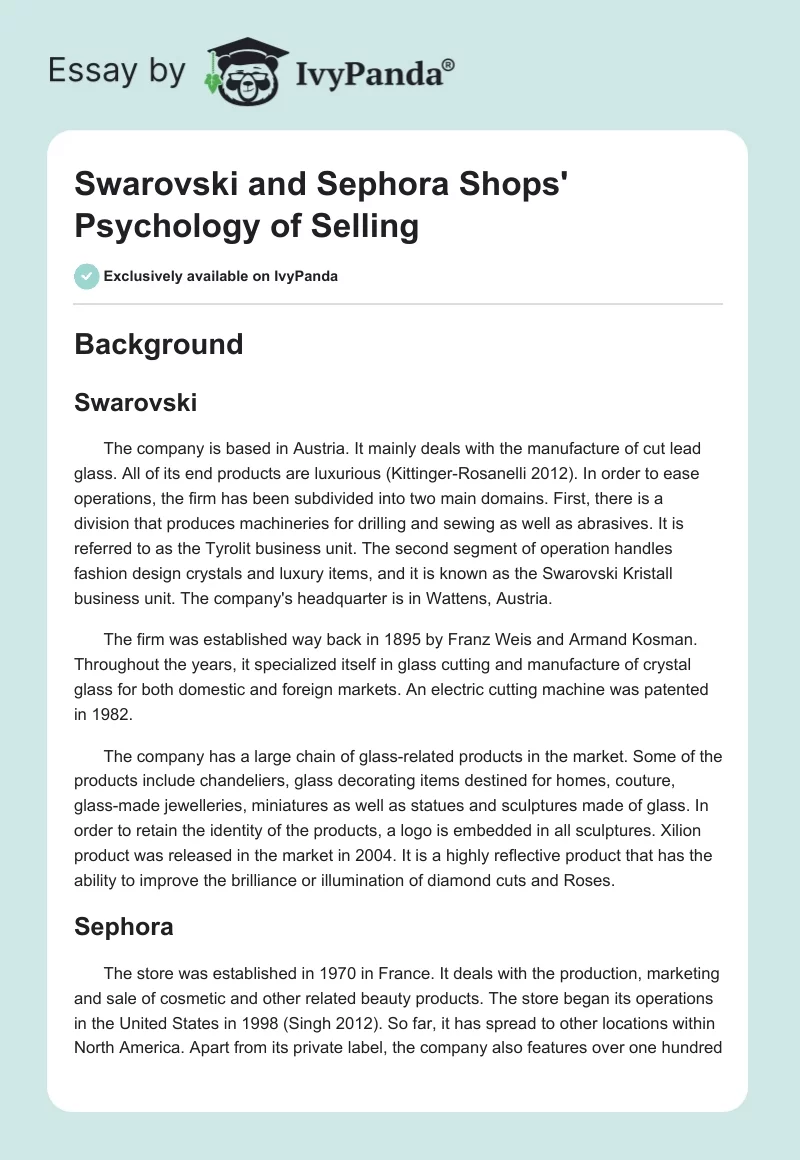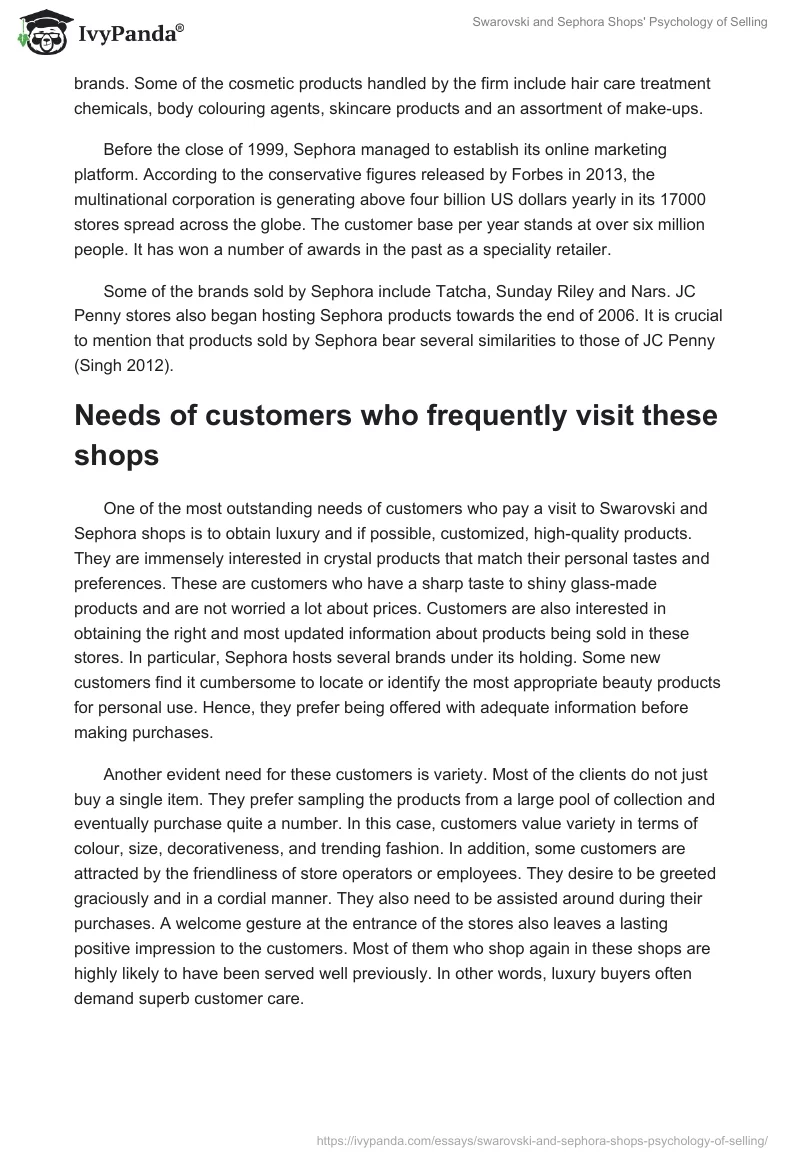Background
Swarovski
The company is based in Austria. It mainly deals with the manufacture of cut lead glass. All of its end products are luxurious (Kittinger-Rosanelli 2012). In order to ease operations, the firm has been subdivided into two main domains. First, there is a division that produces machineries for drilling and sewing as well as abrasives. It is referred to as the Tyrolit business unit. The second segment of operation handles fashion design crystals and luxury items, and it is known as the Swarovski Kristall business unit. The company’s headquarter is in Wattens, Austria.
The firm was established way back in 1895 by Franz Weis and Armand Kosman. Throughout the years, it specialized itself in glass cutting and manufacture of crystal glass for both domestic and foreign markets. An electric cutting machine was patented in 1982.
The company has a large chain of glass-related products in the market. Some of the products include chandeliers, glass decorating items destined for homes, couture, glass-made jewelleries, miniatures as well as statues and sculptures made of glass. In order to retain the identity of the products, a logo is embedded in all sculptures. Xilion product was released in the market in 2004. It is a highly reflective product that has the ability to improve the brilliance or illumination of diamond cuts and Roses.
Sephora
The store was established in 1970 in France. It deals with the production, marketing and sale of cosmetic and other related beauty products. The store began its operations in the United States in 1998 (Singh 2012). So far, it has spread to other locations within North America. Apart from its private label, the company also features over one hundred brands. Some of the cosmetic products handled by the firm include hair care treatment chemicals, body colouring agents, skincare products and an assortment of make-ups.
Before the close of 1999, Sephora managed to establish its online marketing platform. According to the conservative figures released by Forbes in 2013, the multinational corporation is generating above four billion US dollars yearly in its 17000 stores spread across the globe. The customer base per year stands at over six million people. It has won a number of awards in the past as a speciality retailer.
Some of the brands sold by Sephora include Tatcha, Sunday Riley and Nars. JC Penny stores also began hosting Sephora products towards the end of 2006. It is crucial to mention that products sold by Sephora bear several similarities to those of JC Penny (Singh 2012).
Needs of customers who frequently visit these shops
One of the most outstanding needs of customers who pay a visit to Swarovski and Sephora shops is to obtain luxury and if possible, customized, high-quality products. They are immensely interested in crystal products that match their personal tastes and preferences. These are customers who have a sharp taste to shiny glass-made products and are not worried a lot about prices. Customers are also interested in obtaining the right and most updated information about products being sold in these stores. In particular, Sephora hosts several brands under its holding. Some new customers find it cumbersome to locate or identify the most appropriate beauty products for personal use. Hence, they prefer being offered with adequate information before making purchases.
Another evident need for these customers is variety. Most of the clients do not just buy a single item. They prefer sampling the products from a large pool of collection and eventually purchase quite a number. In this case, customers value variety in terms of colour, size, decorativeness, and trending fashion. In addition, some customers are attracted by the friendliness of store operators or employees. They desire to be greeted graciously and in a cordial manner. They also need to be assisted around during their purchases. A welcome gesture at the entrance of the stores also leaves a lasting positive impression to the customers. Most of them who shop again in these shops are highly likely to have been served well previously. In other words, luxury buyers often demand superb customer care.
Techniques used by the salespeople in these shops
Being a detective is the most profound platform used by salespeople in these shops. They have the ability to uncover the needs of customers even before customers make their buying decisions. The salespeople are also in a position to assess the market in terms of the trending styles and fashions and consequently deliver the right products.
The salespeople also listen, observe, combine, ask questions, talk and empathize with customers in the course of selling. In order to uncover the needs of customers and make significant sales, they use the trial-close technique. This selling method does not focus on the purchasing decision of customers. However, it seeks their views. In addition, the technique offers feedback. It is one of the most effective techniques for communicating and obtaining views from customers.
Through the trial-close selling technique, it is possible to know the likeability of the products based on the feedbacks (De Gennaro 2014). It also makes it easy to know whether the targeted buyer is prepared to close the sale.
The Feature, Advantage, Benefit (FAB) selling technique is also used in these shops by the salespeople. For example, the salespeople heavily rely on the physical attributes of the products (such as colour, appearance, size) to make sales. In regards to advantage, the salespeople leverage on the performance advantages of the individual products. Hence, they allow buyers to prove the products as either right or wrong based on performance. Finally, benefit refers to the good outcomes that can be derived from the merits of a product
How to sell better the products/services offered
In order to sell better, the sales team should clarify its sales mission. In other words, it is crucial for the team to fully comprehend the business niche for the respective firms (Kubiak & Weichbroth 2010). For instance, in which areas of product provision do each company excel? Which segments of customers are attracted to the products being manufactured? Which is the best way of approaching the target market? What is the optimum price that customers are willing and able to release for each product? These are some of the questions that the sales team should answer satisfactorily as part of understanding the market.
Second, salespeople should focus on the needs of customers. Prospects should only purchase what they really need and not just buy for the sake of convenience. This might call for a serious emphasis on the individual features of the products being sold. For example, if customers’ need is quality, then the sales team should learn about the same and pass the information to the manufacturing team for adjustments. As a matter of fact, returning customers are usually motivated by satisfying needs from previous purchases.
The salespeople should also create and sustain favourable attention. The latter can be created by developing strategic questions (probing the market), devising viable sales skills, creating strong links in referrals and effective marketing. Maintaining customers also requires a diligent follow-up process.
References
De Gennaro, A 2014, “The trial close: Right time to ask for the sale from optical customer?”, Ophthalmology Times, vol. 39, no. 17, pp. 44-46. Web.
Kittinger-Rosanelli, C 2012, “Creating Crystal Experiences: Mir Talks to Alexander Linder, Director Corporate Consumer And Market Insights, Daniel Swarovski Corporation AG”, GfK Marketing Intelligence Review, vol. 4, no. 2, pp. 52-57. Web.
Kubiak, BF & Weichbroth, P 2010, “Cross- And Up-selling Techniques In E-Commerce Activities”, Journal of Internet Banking and Commerce, vol. 15, no. 3, pp. 1-7. Web.
Singh, S 2012, “The J. C. Penney Company And Sephora USA Partnership: A Case Study”, Journal of Business Case Studies (Online), vol. 8, no. 6, pp. 609-612. Web.


